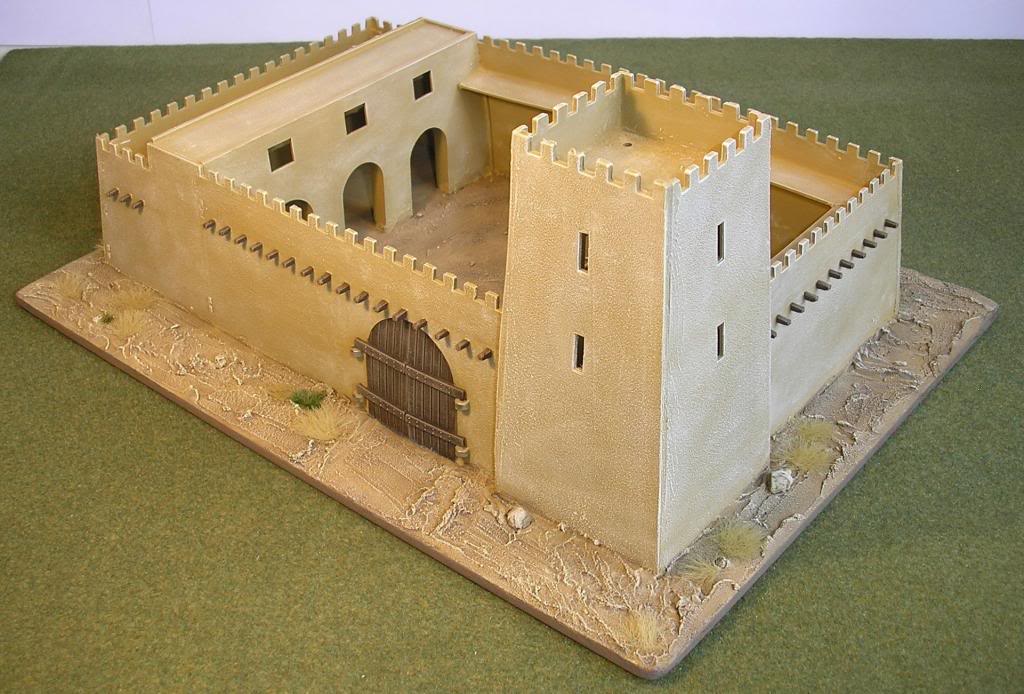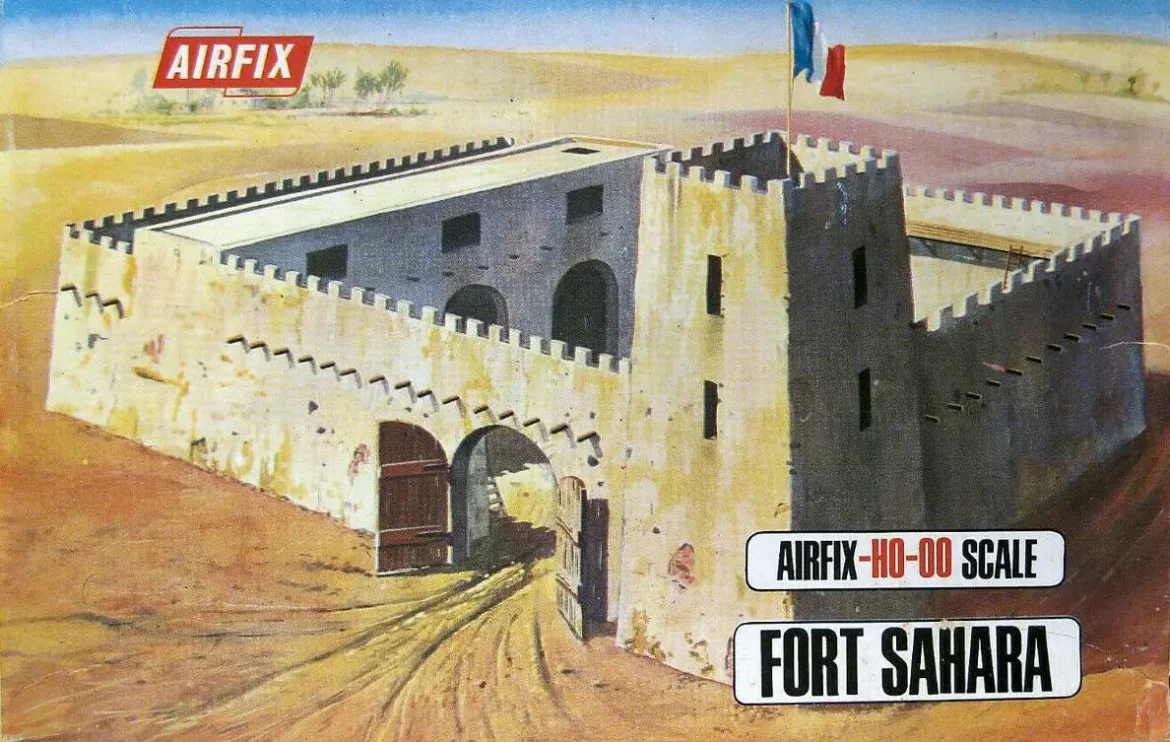Introduction
Among the many vintage model kits produced by Airfix in the golden era of plastic modeling, few evoke the same sense of cinematic adventure and historical mystique as Fort Sahara. Originally released in the 1960s as part of Airfix’s HO/OO scale playset series, Fort Sahara was a unique departure from their typical WWII battlefield themes. Instead, it tapped into the romanticized vision of French Foreign Legion outposts in North Africa — remote, sand-blasted fortresses standing alone against vast desert landscapes and hostile tribal forces.

Fort Sahara represents more than just a plastic model. It embodies a genre: the desert adventure stories of Beau Geste, Lawrence of Arabia, and countless mid-century war films. Though not tied to a specific historical structure, its design draws from real architectural features found in French colonial outposts across Algeria, Tunisia, and Morocco. For hobbyists, it offered endless possibilities — whether for war gaming, story-telling, or display.
The Historical Inspiration Behind Fort Sahara
Fort Sahara is not a replica of a single known fortress but rather a stylized interpretation of Foreign Legion desert forts, particularly those found in North Africa during the late 19th and early 20th centuries. These forts were built by French colonial forces to maintain control over vast, often rebellious territories. They were typically:
- Constructed of mudbrick or stone
- Boxy and utilitarian in appearance
- Situated in isolated locations with minimal supply lines
- Staffed by Foreign Legionnaires tasked with defending imperial interests
The classic image of such forts — square ramparts, corner towers, gates, and internal courtyards — is captured effectively in the Airfix model. While simplified for scale modeling, Fort Sahara captures the ambiance of these locations, complete with lookout towers and fortified walls.
What’s in the Box?
Airfix Fort Sahara was part of their HO/OO (1:72 scale) line, intended to be compatible with their military figures and vehicles. The original kits came molded in a sandy beige or desert tan color, though repainting was encouraged for realism.
The kit typically included:
- Four Perimeter Walls: Molded sections featuring crenellated tops, loopholes for rifles, and textural details suggesting adobe or stonework.
- Corner Towers: Two or more elevated bastions for guards and sentries, with flat tops ideal for mounting machine guns or lookouts.
- Central Gate Section: Featuring large wooden-style gates that could be opened and closed. The arch above the gate often carried a stylized emblem or stonework detailing.
- Courtyard Buildings: Small inner structures like a barracks, command office, or storage rooms.
- Flagpole and Accessories: Some sets included extras like crates, barrels, or a flagpole to represent national or regimental banners.
The set was simple to assemble and designed for robust play. The walls could be arranged flexibly, allowing modelers to customize the shape of the fort — square, rectangular, or L-shaped configurations were all possible.
Diorama and Play Potential
One of the main attractions of Fort Sahara was its immense potential for storytelling. Unlike traditional war kits centered on a specific event or battle, this set invited users to create their own scenarios, missions, and sieges.
Possible Diorama Themes:
- Beau Geste-style Desert Siege
A handful of Foreign Legionnaires defend the walls of Fort Sahara against waves of desert tribesmen. Smoke rises in the distance as drums sound the approach of enemy riders. With sandbags piled high, and machine guns mounted atop the towers, the defenders prepare for their final stand. - French Colonial Garrison Life
Use the fort as the backdrop for daily life in a desert posting — soldiers marching, cleaning their weapons, raising the French tricolour, or writing letters home from the shaded barracks. - North African Campaign (WWII)
Adapt the fort to a World War II setting. Perhaps it has been abandoned and occupied by German Afrika Korps troops or used by the British 8th Army as a desert command post. - Desert Adventure Movie Set
The fort could represent a backdrop from a 1950s or ’60s desert adventure film, complete with palm trees, camels, an oasis, and enemy agents hiding in the shadows.
Painting and Weathering
Though the original kit came in single-color plastic, many modelers take pride in painting Fort Sahara to achieve a more realistic look.
Suggested Techniques:
- Base Color: A sand, beige, or ochre tone is appropriate for desert forts. Dry-brush with lighter shades to bring out texture.
- Weathering: Add grime, dust, and chipped paint effects using washes, pastels, or airbrush techniques.
- Details: Paint wooden gates with wood grain effects and add metallic touches to hinges. Doors and windows can be accented in darker browns or blacks.
- Interior Scene Building: Use fine sand, small stones, or textured paste to simulate a desert courtyard floor. Add crates, weapons racks, or even a well.
To enhance realism, some hobbyists also incorporate third-party accessories such as palm trees, camels, tents, or figures from other manufacturers.
Figure Compatibility
Airfix designed Fort Sahara to match its HO/OO military figures, particularly the Airfix Foreign Legion and Arab Warriors figure sets. These soft plastic miniatures were iconic in their own right, often used in imaginative battles atop sand-colored carpets or garden dirt mounds.
Ideal Figure Sets to Pair:
- Airfix Foreign Legion – Soldiers with rifles, bayonets, and classic kepis.
- Airfix Arab Warriors – Figures with scimitars, spears, and flowing robes.
- Airfix WWII Infantry – British 8th Army or Afrika Korps troops for a WWII setting.
- Esci or Revell 1:72 sets – Useful for expanding your desert-themed force.
The size compatibility allows for seamless integration into wargames, stop-motion animation, or display scenes.
Legacy and Collector Appeal
Fort Sahara, while long out of regular production, remains a highly sought-after vintage kit. Original boxed sets from the 1960s or 1970s can command high prices on auction sites, especially if unbuilt and complete. Even broken or used sets are valued by collectors wanting to restore them or use the pieces in new layouts.
The nostalgia factor is significant — many modelers fondly remember receiving Fort Sahara as children, using it as the centerpiece for epic living room battles. The set’s unique theme, distinct from tanks and trenches, helped it stand out in the Airfix catalog and earned it a lasting place in the hearts of hobbyists.
Rarity:
- Complete sets with the original box art are rare.
- Some reissues were produced, often with different packaging.
- Third-party reproductions and resin conversions have appeared online.
Reimagining Fort Sahara Today
Modern technology and materials offer exciting possibilities for revitalizing the Fort Sahara concept:
- 3D Printing: Several hobbyists have scanned original components to create STL files for custom printing or upscaled versions.
- Laser-cut MDF kits: Some companies produce North African-style forts that echo the Airfix original.
- Hybrid Dioramas: Combine plastic, foam, and resin to create a massive desert fortress with custom additions like inner courtyards, stables, or observation posts.
There’s also a vibrant online community sharing custom builds, paint jobs, and gameplay scenarios — keeping Fort Sahara alive decades after its original release.
Conclusion
Airfix Fort Sahara is more than just a plastic fort — it’s a gateway to a thousand imagined adventures across the sun-scorched dunes. From cinematic sieges to historical reenactments, it captures the spirit of an era when modeling wasn’t just about military accuracy, but about storytelling, creativity, and play.
In a world of hyper-detailed modern kits, Fort Sahara still shines as a timeless classic — charming in its simplicity, rich in potential, and endlessly evocative. Whether you’re restoring a vintage set or discovering it for the first time, building Fort Sahara is a journey into the heart of the desert — and the imagination.

